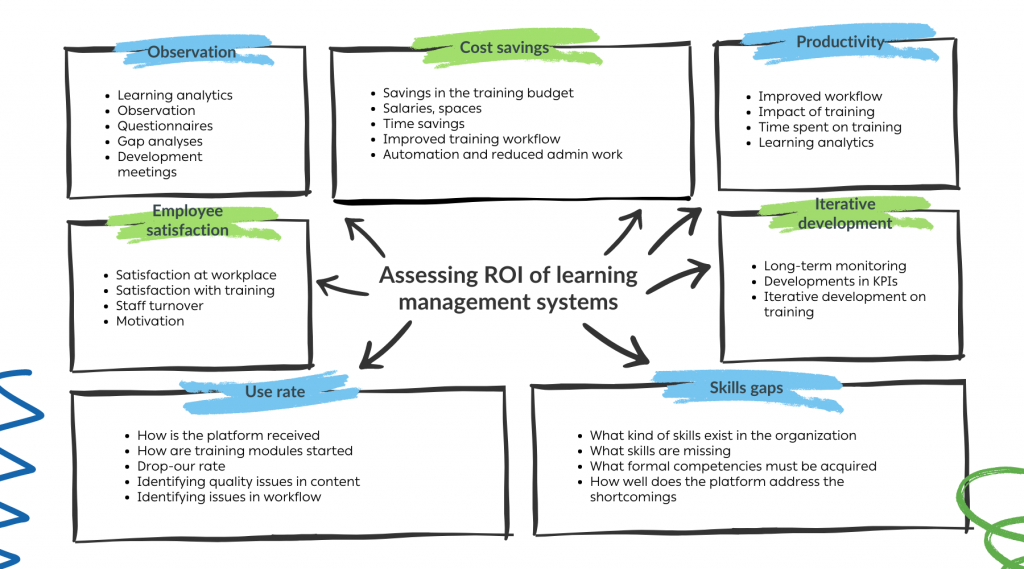Investment in training and upskilling pays itself back – with interests. ROI of online training is generally quite impressive.
You have likely heard this claim before. For instance Indeed job portal has said it is true – and so have we. There is considerable evidence that indicates that opportunities to learn and improve are a significant factor in employee welfare. They impact productivity of work and staff turnover.
A good training and upskilling program is an excellent investment in an organization’s long term competitiveness. But how can you pin down the exact ROI of online training?
What are the relevant metrics for impact and ROI of online training?
Different organizations have different priorities. The most relevant metrics may not be the same across all companies. There is no one correct way to measure the value or the impact of a training program. First it is important to understand the priorities and practices of a given organization to determine relevant metrics for the ROI of online training.
A particular challenge with measuring ROI of online training usually leads to indirect returns. Training as such does not generate income, but it does impact several key indicators of productivity. Organizing training as online courses may lead to cost savings, but also improve productivity, close skill gaps, or improve well-being.
To understand the ROI of online training , you must understand your metrics. Usually metrics fall into three broad categories:
Direct cost savings. Organizing training online or in hybrid format is usually more cost effective than traditional corporate training. Online training often involves automatizing training, reducing administrative work, and improving efficiency of teaching. Training may also involve concrete improvements in work efficiency that can be measured in monetary terms.
A company might measure reduction in cost, reduction of working time spent outside productive work, changes in training modules passed, changes in staff turnover, time spent on new employee onboarding, or changes in other productivity metrics.
Employee satisfaction. Measuring satisfaction among staff is less concrete than measuring costs or time. However, it might provide richer data on phenomena that have a more long-term impact on productivity. Measuring employee satisfaction requires more qualitative tools, such as interviews, development meetings, and observation.
Measurements may be more expensive to execute, but give a deeper understanding on how the organization works.
In larger organizations staff turnover and recruitment costs can also be valuable metrics on satisfaction. Larger organizations can also benefit more from mixed-method research and scalable data collection methods like questionnaires.
Fixing skills gaps. For learning-oriented organizations training is not an obligation, but rather a way to improve staff skills. These organizations aim to understand their weaknesses and improve their human capital. Training becomes a part of the strategy, and it aims to improve competitiveness in the long run.
Skills gaps are identified through systematic analysis. HR aims to understand what skills and competencies already exist in the organization, what skills are needed, and how to acquire the missing skills. HR will work to continuously measure training impact and develop training programs iteratively.
Learning environment makes training budget transparent
It is often difficult to collect reliable data on the ROI of online training . Data collection can be a burden for experts working in human resources, learning and development, and financial management.
A digital learning environment is not only a valuable tool for publishing and managing online training courses – it can also contribute to better data driven decision making. An LMS creates qualitative and quantitative data that management can use to better allocate resources and understand training needs.
A learning environment helps to collect data on the ROI of online training such as:
Use rate. While it is occasionally challenging to measure how engaging face-to-face training really is, it can be very easy to measure how well an online training program has been received. Human resources can monitor in almost real time what training modules have been started and completed, which assignments have proven to be problematic, how much interest there has been to certain contents, and so on. All this data helps organizations determine how well a new program has been implemented and what can be improved.
Content quality. A digital learning environment makes it easy to monitor groups or individuals. At the same time HR can monitor which specific content modules have been popular and how changes to content impact learning outcomes. Content creators can assess the quality of contents and identify needs for improvement.
Skills and skill gaps. Managing competencies and skills is a key component of human resource management. A digital learning environment will make defining learning goals and managing completed training programs easy and automatic. With adequate tools HR can understand which training modules are needed and how resources can be best allocated.
User surveys. It is possible to measure staff well-being indirectly through productivity and staff turnover. Different surveys can provide richer data on employee opinions and help develop learning programs. Surveys can contain standardized and open questions for both comparable and rich data to better understand user needs.
Development over time. No metric is useful without context. No single number or questionnaire can provide insight on its own. Rather, all results must be compared to a benchmark. Digital environments help generate historical data to understand how metrics change and compare to other time periods.

Do you want to develop training in your organization based on data?
Workseed LMS is a working-life oriented learning environment. It provides you all the necessary tools that make new employee on-boarding and continuous training easy to manage. It also makes assessing the ROI of online training easy and transparent.
Many companies have already improved their training workflow with Workseed. For instance the Finnish retail staffing agency Joblink uses Workseed to manage their extensive portfolio of different training and on-boarding programs between a number of stakeholders.
If you want to know more about Workseed and its features, feel free to book a demo here. Our experts can help you design a better way to manage learning and training in your organization and understand the ROI of online training.










